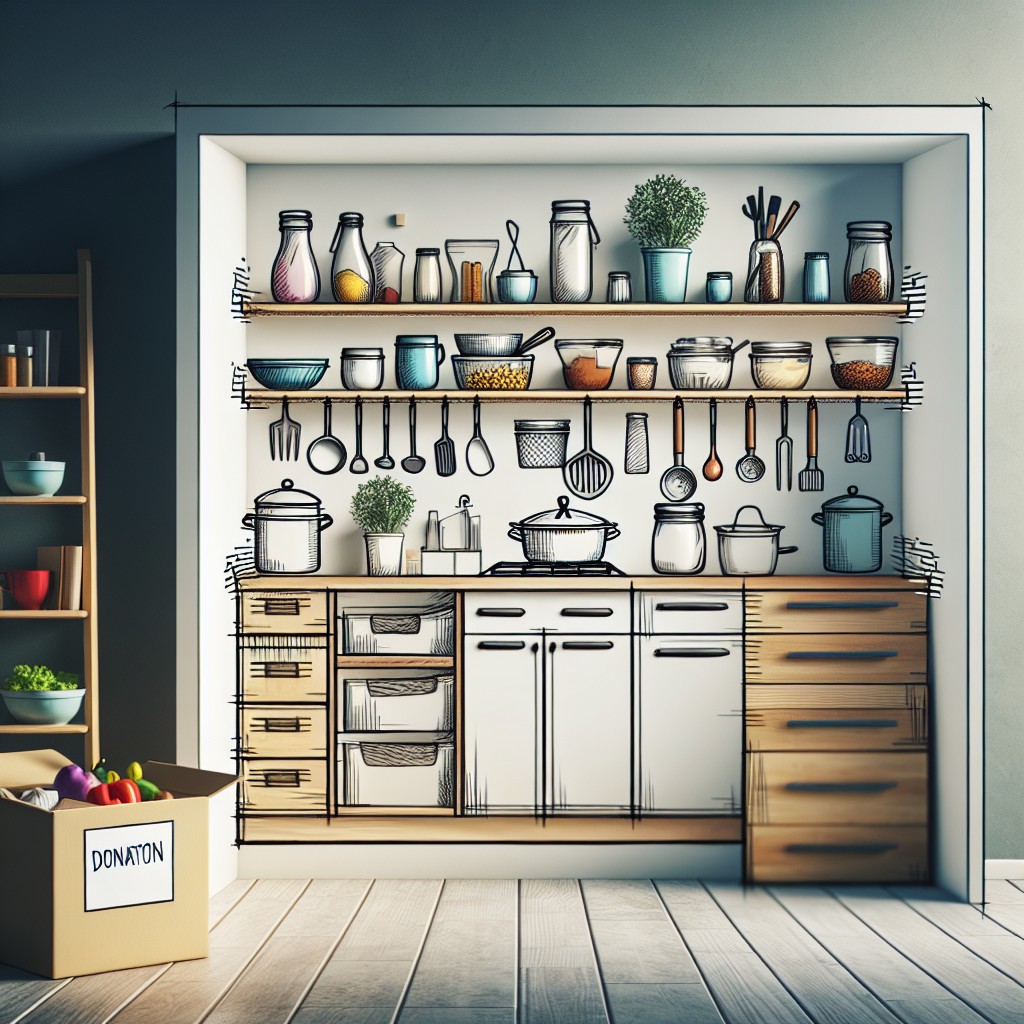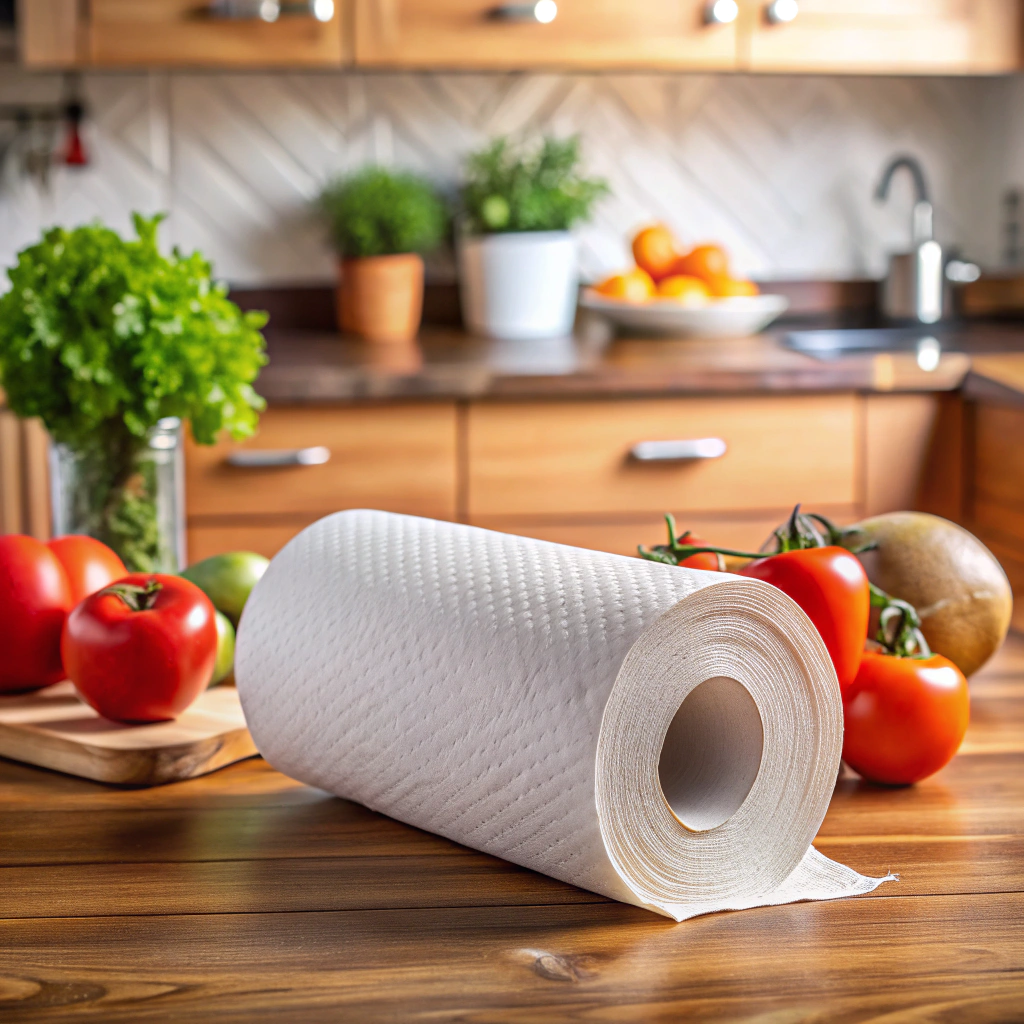Last updated on
Maximizing efficiency while minimizing clutter, this article provides easy-to-follow steps on organizing your kitchen for optimal use.
Key takeaways:
- Declutter, Upcycle, and Donate
- Make a Plan That Suits How You Use Your Kitchen
- Organize Kitchen Cabinets, Drawers, and Shelves
- Use Vertical Storage and Kitchen Doors for Optimum Ergonomics
- Schedule a Regular Clear Out to Maintain Order
What's Inside
Declutter, Upcycle, and Donate

Embarking on the journey of kitchen organization begins with whittling down your belongings to the essentials. Embrace the freeing practice of decluttering by reviewing each item in your kitchen and asking yourself if you’ve used it in the past year. If it hasn’t served a purpose recently, it’s probably not essential.
Upcycling is your creative companion in reducing waste. Consider converting old jars into storage for bulk goods or using an outdated cake stand as a two-tiered spice rack. Such inventive solutions not only give old items a new lease on life but also add a personal touch to your kitchen space.
For items that no longer serve your household but are still in good condition, donating is a generous way to extend their usefulness. Local charities, shelters, and community centers often welcome kitchenware with open arms. By donating, you contribute to a cycle of kindness and sustainability while streamlining your cooking sanctuary.
Make a Plan That Suits How You Use Your Kitchen
Aligning your kitchen to your culinary habits transforms the space into a bastion of efficiency. Consider these points to tailor the perfect kitchen plan:
- Identify your cooking flow: Pay attention to steps you often take from the fridge to the stove to the sink. Position items used in each step within arm’s reach of that station to save time and footsteps.
- Zoning for victory: Create distinct zones for prepping, cooking, and cleaning. Each zone should have the tools and supplies needed for its particular function readily accessible.
- Adapt to the specifics: Cater to dietary preferences or cooking styles. If you’re a baker, create a dedicated baking station with mixing bowls, measuring cups, and baking ingredients neatly organized.
- Double down on dinnerware: Everyday plates, glasses, and cutlery should reside near the dishwasher for easy unloading or close to the dining area for swift table setting.
- Account for appliances: Frequently used appliances earn counter space, while occasional-use gadgets can be stored away to avoid clutter.
Implementing these pointers ensures that your kitchen becomes a perfect reflection of your cooking lifestyle, paving the way for hassle-free meal prep and enjoyment.
Organize Kitchen Cabinets, Drawers, and Shelves
To transform chaos into a culinary haven, categorize items by usage. Place everyday dishes on an accessible shelf, keeping special-occasion pieces higher up. Stack pots and pans neatly, with lids on the side for easy grabbing.
For optimizing drawer space, divider trays are a game-changer. They’ll keep utensils compartmentalized, ensuring a spoon is always within reach. Store wraps and foils in a drawer near the fridge to make food storage a breeze.
Implement risers for canned goods to see everything at a glance, avoiding the dreaded double purchase. Think about those less-often-used appliances. Could they be stowed away to free up counter space? Often, the answer is a resounding yes.
Lastly, don’t forget about the potential of under-shelf baskets. These nifty additions can dramatically increase your storage options, perfect for holding napkins, tea towels, or lightweight snacks. With these strategies, every culinary tool will be just where you need it, exactly when you need it.
Use Vertical Storage and Kitchen Doors for Optimum Ergonomics
Maximizing vertical space adds a new dimension to kitchen storage, allowing for a more efficient and ergonomic organization. Here are some practical tips:
- Install shelves or hanging racks above the sink or countertop to keep essentials within reach without cluttering work areas.
- Use wall-mounted spice racks, knife magnets, or utensil hooks to free up drawer space while keeping cooking tools at eye level.
- Employ over-the-cabinet-door organizers for items like cutting boards and cleaning supplies, which often take up valuable shelf space.
- Consider ceiling-mounted pot racks for an accessible yet out-of-the-way solution for large cookware.
- Use stackable shelves or tiered organizers in cabinets to elevate items in the back, making it easier to grab what you need without digging through piles.
Leverage these vertical spaces to arrange your kitchen tools strategically, aiming for a blend of convenience and minimalism. This approach not only streamlines your workflow but also makes it a pleasure to work in your well-organized kitchen.
Schedule a Regular Clear Out to Maintain Order
A tidy kitchen isn’t a one-time affair; it’s an ongoing commitment. To keep clutter at bay, mark your calendar for a bi-annual review of your space. During these check-ins, assess items for wear and tear or lack of use. If your juicer has gathered dust for months, maybe it’s time to pass it on to a friend who’ll give it the love it deserves.
Embrace the one in, one out rule – whenever a new gadget or dish enters the kitchen, ensure an old one exits. This way, you maintain equilibrium rather than accumulating excess. Remember, the goal is to have everything in your kitchen earn its keep by being useful and frequently used.
Be sure to also check expiration dates on pantry items. Spices lose potency, and canned goods have their limits. Tossing expired items ensures your cooking ingredients are always fresh and your meals, top-notch.
These regular clear-outs are your secret weapon against clutter creep. Your kitchen will not only look good but will function efficiently, creating a harmonious environment for culinary creativity.




